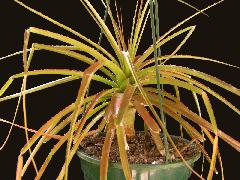
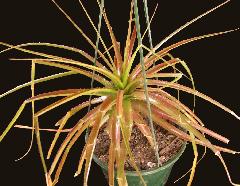
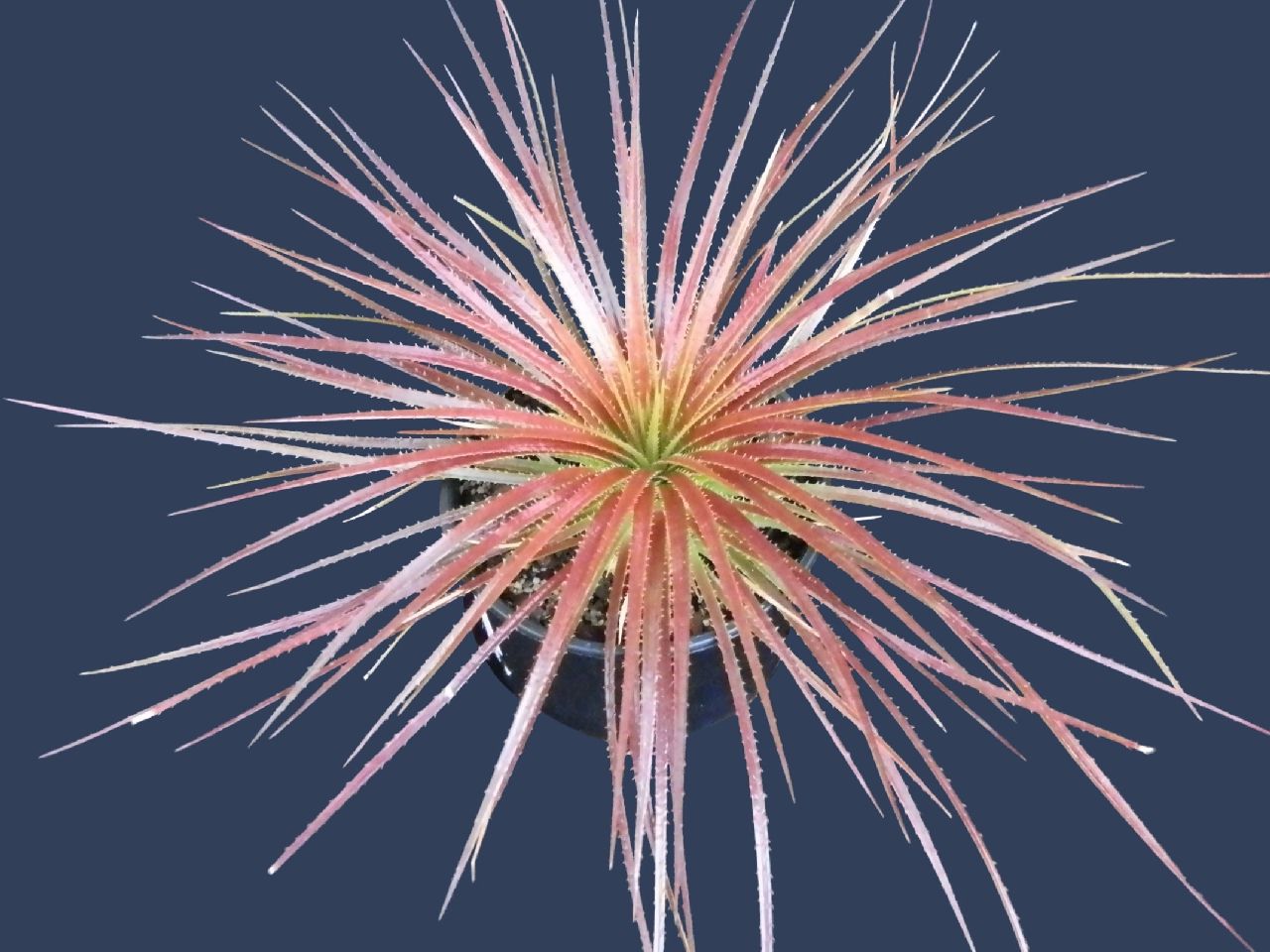
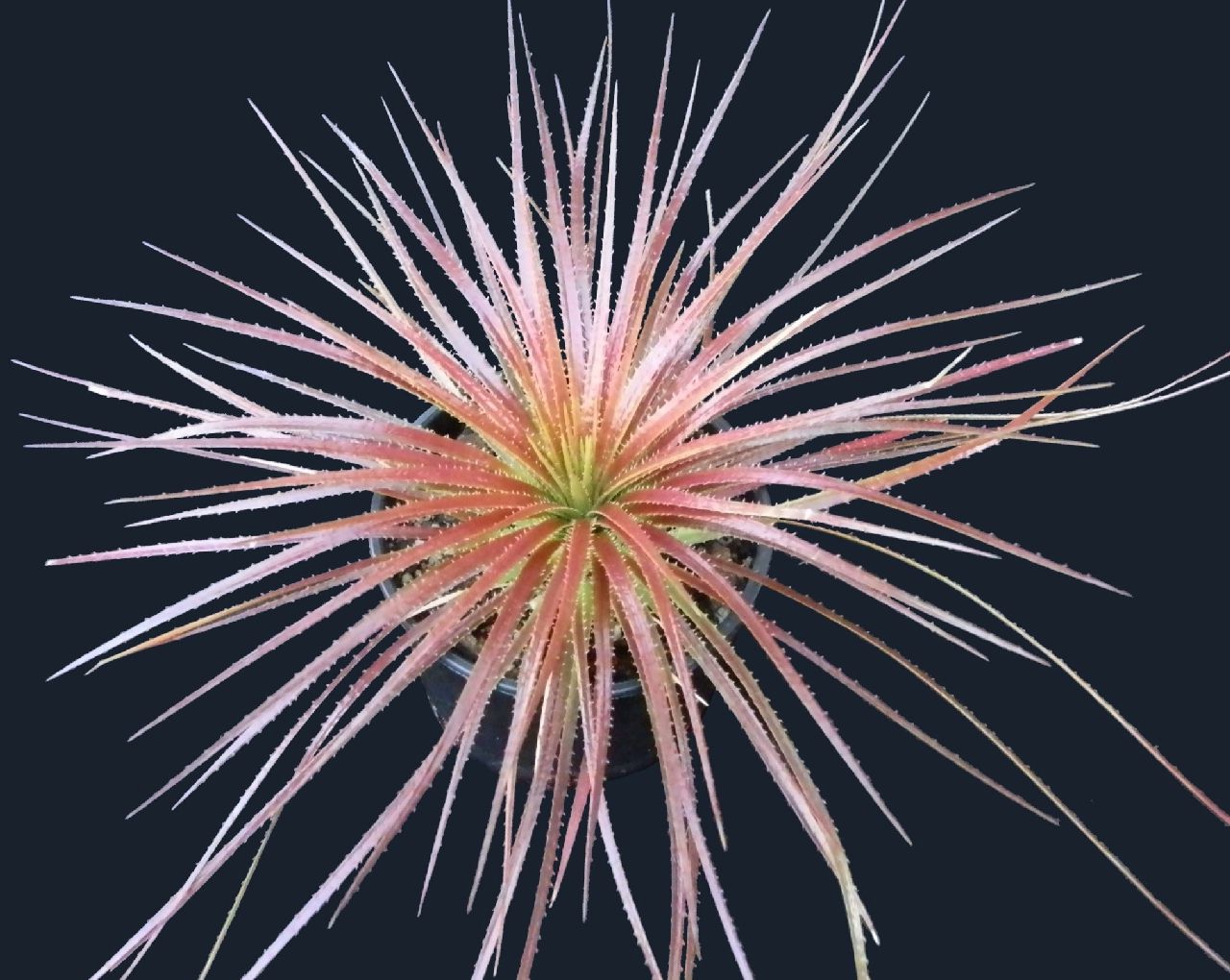

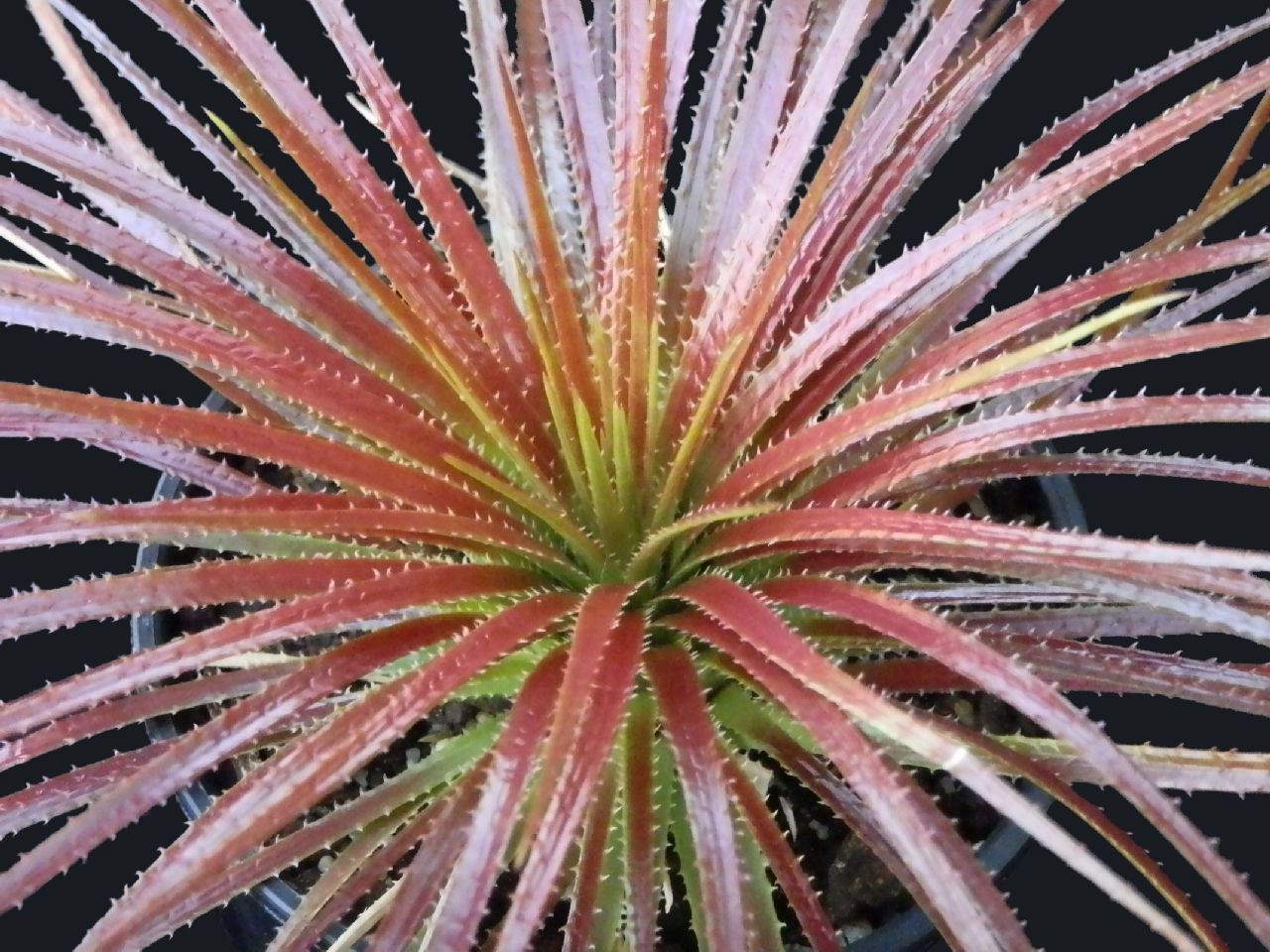
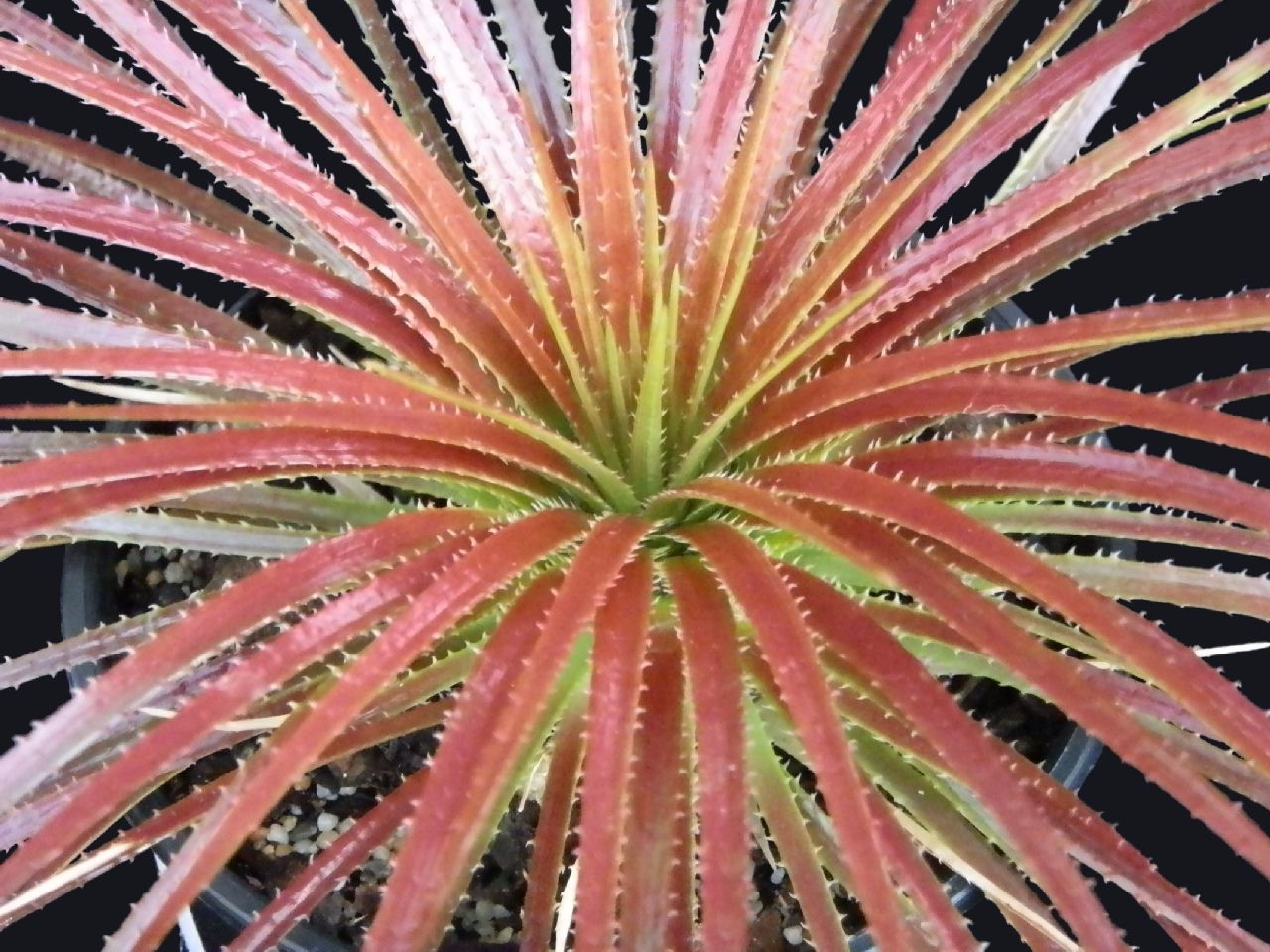
Orthophytum navioides (L.B. Sm.) L.B. Sm., Smithsonian Misc. Collect. 12b(i): 33. 1955.
= Cryptanthopsis navioides L B. Sm., Contr. Gray Herb. 129: 31. 1940.
Tipo: BRASIL. BAHIA: Jacobina, 16-VI-1934, M B. Foster & R. Foster 90 (holotipo: GH; isotipos: SP!, R!).
Detail from Louzada & Wanderley in Hoehnea 35(3): 405-10. 2008
Translated by Derek Butcher
Herbs rupicolous of small size, stoloniferous, stolons covered by toothed cataphylls; short stem, ca 2 x 1,5 cm.
Leaves numerous, densely imbricate, 9,5-24 cm;
Sheaths whitish, triangular, ca. 1 x 1,5 cm, glabrous, margins spinescent, spines 0,5 mm long;
Blades coriaceous, green, lucid, the most internal ones red, linear-triangular, 8-23 x 0,4-0,7 cm, sparsely lepidote on both faces, margins spinescent, spines retrorse at the base, antrorse at the apex, 1-1,5 mm long, apex long attenuate.
Inflorescence sessile, multiflowered, simple.
Floral bracts subcoriaceous, green, symmetrical, carinate, triangular, ca. 2 x 1 cm, lepidote, margins spinescent, apex mucronulate.
Sepals green, symmetrical, carinate, narrow triangular, 2-3 x 0,5 cm, with capitate trichomes, margins entire, acuminate-attenuate apex.
Petals white, linear - spatulate, ca. 2,5-3 x 0,4 cm, margins entire, apex subacute, petal appendages sacciform, lacerated, to ca. 3 mm from the base of petals.
Epigynous tube ca. 1,5 mm long.
Stamens of the first whorl adnate to the petals in the basal portion, free portion of the filaments ca. 9 mm long, second whorl with free filaments, opposite to the sepals, filaments ca. 2 cm long, anther ca. 2,3-3 mm long, obtuse apex.
Ovary trigonous, style ca. 2 cm long, stigma erect simple.
Fruit and seed not seen.
Material examined: BRAZIL. Bahia: Jacobina, 4-VII-2003, H. Ribeiro & O. Ribeiro s.n. (HB54815); Cachoeira Véu da Noiva, 27-X - 1995, G. Jardim et al. 729 (CEPEC).
The only recordings of this species are referred to the municipal district of Jacobina in the state of Bahia, inhabiting shaded rocks in gallery forests.
Orthophytum navioides was described by Smith(1940), under the genus Cryptanthopsis. In 1955, the same author transferred the species to the genus Orthophytum, meanwhile without justifying such proposal (Smith 1955).
Orthophytum navioides resembles O. mucugense Wand. & Conceição for the similar habit, colouration and texture of leaves, bracts and sepals, but these species differ in the length of the leaf blades and the reproductive structures.
Butcher's note:
This changes the concept below where O. ophiuroides was included in the O. navioides description.
Orthophytum navioides (L.B. Sm.) L.B. Sm. Smithson. Misc. Collect. 126: 34, 179.1955.
Amended by Wand. & Conceicao, Sitientibus Serie Ciencias Biologicas 6(1): 3-8. 2006.
Differences not noted by Wanderley from S&D description in brackets.
Herb rupicolous, spreading by long stolons, ca. 6,5cm long; robust underground stem, ca. 3 x 2cm, hidden by the imbricate leaflike sheaths.
Leaves numerous, recurved, erect to suberect in juvenile plants, 5,5-25cm long;
Sheaths whitish, elongated, ovate, edges spinulose at the apex;
Blades subcoriaceous, slightly canaliculate, brilliant green, linear, 5-24 x 0,2-0,4cm, (8mm), apex long attenuate, sparsely lepidote on both faces, abaxial face nerved, glandular trichomes absent, edges spinulose, spines antrorse, 0,3-0,4mm.(1mm)
Inflorescence sessile, many flowered, ca. 15-20-flowered, ca. 1,5-2cm wide, flowers surrounded by a red ring formed by the base of the leaves and the involucral bracts, contrasting strongly with the remaining green rosette; predominant branching of the inflorescence, with outside fascicles with 2-3 flowers per bract, in profile;
Primary bracts foliaceous, red, oval-filiform to oval - lanceolate, long attenuate, 2-8,5cm, tip acute, lepidote on both faces, especially on the abaxial, margins denticulate, the central part of the inflorescence has a reduction in branching, with each floral bract carrying a single flower, in profile.
Floral bracts oval-lanceolate, shorter than the sepals, ca. 1 cm long, glabrous, margins denticulate, apex long attenuate. Hypanthium tube inconspicuous.
Calyx with red sepals, connate just at the base, asymmetric, ca. 1 cm long,(3cm), strongly carinate, apex attenuate.
Corolla white, petals linear, ca. 1,5cm, with 2 lacerated petal appendages, ca. 5mm from the base, callosity flanking the filaments.
Stamens included, ca. lcm long, filaments flat, anther linear, ca. 2,2mm long.
Ovary trigonous, 4-5mm long, stigma spiraled; placenta axial, ovules numerous.
Fruit with persistent sepals, trigonous, ca. 4mm long; seeds ca. 15, chestnut, irregular shaped, ca. 1,5mm long, grooved.
Material examined: BRASIL: BAHIA, Lencois, (200kms from Jacobina) Chapada Diamantina. Rupicola no Poco Halley, col. R.B. Louzada & C.A.C. Moreira 07, 13/I/2006 (SP); trilha para a cachoeira da Primavera, col. R.B. Louzada & C.A.C Moreira 08, 13/I/2006 (SP); cachoeira da Primavera; col. R.B. Louzada & C.A.C Moreira 09, 13/I/2006 (SP); Cachoeira Mandassaia, col. M.G.L. Wanderley et al. 2531, 15/I/2006 (SP); M.G.L. Wanderley et al. 2532 (SP).
Habitat: the species occurs on vertical rocky faces, in general more than 30m high, at the edge of rivers and waterfalls, in shady and out of the way places, many times at points where water drainage occurs from the mountains. The substratum shallow and and principally full of entangled roots.
Distribution: species referred to previously as only from the type locality, Jacobina in the Chapada Diamantina, Bahia. In the present work new places of occurrence are added to the area, in the municipal district of Lencois, in river waterfalls that are in the mountains of the Parque Nacional da Chapada Diamantina.
Orthophytum navioides was described as Cryptanthopsis navioides by Smith (1939), based on material - Foster 90, coming from Jacobina, in Bahia. The holotype is deposited in G and the isotypes in SP, RB and US. In habit, fragile with linear leaves, narrow and long caudate and the presence of long stolons, are typical characteristics of this endemic species from Chapada Diamantina. However, except from vegetative parts, the morphology of the inflorescence and of the flowers are not particularly detailed in the original description. A very evident characteristic, not advised in the literature, is the red coloration of the center of the rosette at anthesis, making it quite ornamental. In the description in Smith & Downs (1979) the same illustrations of the original work and any additional material are maintained, showing the identity of this species, in general, is unknown. In the herbarium collections, other species of the genus are mistakenly identified under the name of O. navioides. Based on new collections obtained for the present work, a better recognition of the species was made possible, with the presentation of a more detailed description, in addition with more complete illustrations of the vegetative and reproductive structures of the plant.
As mentioned in the comment on O. mucugense, this species is similar to O. navioides, especially for the small size of the plant and leaves glabrous or glabrescent. Leme (2004a) links O. heleniceae with O. navioides, although it has just compared from cultivated material and the type material of the latter species. However, those two species are very different, being recognized easily by various characteristics, among them the larger size and width of the leaves of O. heleniceae, in addition to the margins conspicuous serrate and center of the rosette with two rings of very contrasting colors.
The species of Orthophytum with sessile inflorescences occurring in Chapada Diamantina are very attractive because of the colour of their bracts and leaves, in general, red at anthesis, having high ornamental potential and visual attraction to hummingbirds. The leaves, in spite of being spiny or serrate, are an ornamental characteristic of the species of the genus Orthophytum as a whole. Most of the species have leathery leaves, being covered with adpressed grey scales, especially in the xeric species, and being membranaceous and glabrous or with scarce indument in the species from humid areas.
The taxonomic problems involving Orthophytum is largely in the current shortage of good herbarium collections and of the little knowledge of the populations in situ. A great part of the characteristics of a species are lost in herbarium specimens, especially for the presence of congested inflorescences in the species without a scape. In that sense, attention should be given to the study of inflorescence patterns.
In addition the careful morphologic study accomplished through analysis of individuals in the field and of live collections, the use of new tools, such as anatomical data, cytogenetics and molecular studies will be fundamental for the infra-generic delimitation of Orthophytum.
Orthophytum navioides (L. B. Smith) L. B. Smith, Smithson. Misc. Collect. 126: 34, 179.1955.
Cryptanthopsis navioides L. B. Smith, Contr. Gray Herb. 129: 31, pI. 3, figs. 4-6. 1940.
Desc from S&D
Plant stemless, propagating by elongate stolons, reddish at anthesis.
Leaves numerous, spreading, very densely rosulate, 3 dm long;
Sheaths small, scarcely distinct, very densely and minutely serrulate;
Blades very narrowly triangular, to 8 mm wide, sparsely and obscurely punctulate-lepidote on both sides, subdensely serrate with slender mostly antrorse spines 1 mm long.
Inflorescence capitate, few-flowered, sunk in the center of the rosette.
Floral bracts narrowly triangular, serrulate, the inner shorter than the sepals;
Flowers sessile.
Sepals free, straight, symmetric, narrowly triangular, attenuate, nearly 3 cm long;
Petals white when dry, append aged above the base;
Ovary strongly compressed, to 5 mm long.
Type. Foster 90 (holotype, GH; isotypes R, US), on perpendicular rocks above stream in isolated ravine, Jacobina, Bahia, Brazil, 16 Jun 1939.
Distribution. Known from the type collection only.
Flora of Pico das Almas 1995, p655
Orthophytum navioides (L.B. Sm.) L.B. Sm. vel. aff., Smithsonian Misc. Collect. 126(1): 34,179 (1955).
Stemless, rosette-forming herb; rosette c. 21 cm diam.
Leaves numerous, recurved;
Sheath indistinct and broader than blade;
Blade 10-15 cm long, gradually tapering to apex, reddish in the central part, glabrous, margins serrulate.
Inflorescence nidular;
Scape absent;
Floral bracts erect, c. 1 cm long x 0.12 cm broad, apex recurved, margins sparsely serrulate, striate.
Flowers numerous, sessile.
Sepals free, c. 1 cm long x c. 0.3 cm wide, narrowly triangular, margins entire.
Corolla white.
On rocks.
Mun. Rio de Contas: Pico das Almas. 1400-1800 m. Arrais et al, CFCR 6917.
This species differs from 0. burle-marxii L.B. Sm. & Read in its glabrous leaves and reddish leaf-bases.